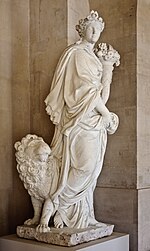Earth (classical element)
| Classical elements |
|---|
Earth is one of the classical elements, in some systems being one of the four along with air, fire, and water.
European tradition

Earth is one of the four
In Classical Greek and Roman myth, various goddesses represented the Earth, seasons, crops and fertility, including
In

In alchemy, earth was believed to be primarily dry, and secondarily cold, (as per Aristotle).[3] Beyond those classical attributes, the chemical substance salt, was associated with earth and its alchemical symbol was a downward-pointing triangle, bisected by a horizontal line.
Indian tradition
Prithvi (Sanskrit: pṛthvī, also pṛthivī) is the Hindu earth and mother goddess. According to one such tradition, she is the personification of the Earth itself; according to another, its actual mother, being Prithvi Tattwa, the essence of the element earth.
As or Mercury who represents communication, business, mathematics and other practical matters.
Ceremonial magic
Earth and the other Greek classical elements were incorporated into the
It is sometimes represented by its Tattva or by a downward pointing triangle with a horizontal line through it.
Modern witchcraft
Earth is one of the five elements that appear in most
Other traditions
Earth is represented in the
; bulls and birds.See also
- Gaia (mythology)
- Mother goddess
- Mother nature
- Pherecydes of Syros
Notes
- ^ Plato, Timaeus, chap. 22–23; Gregory Vlastos, Plato's Universe, pp. 66–82.
- ^ G. E. R. Lloyd, Aristotle, chapters 7–8.
- ^ "Aristotle". chemed.chem.purdue.edu. Retrieved 2019-04-18.
- ^ Israel Regardie, The Golden Dawn, pp. 154-65.
- ^ Regardie, Golden Dawn, p.322; Kraig, Modern Magick, pp. 149-53.
- ^ Regardie, Golden Dawn, p. 80.
- ^ Regardie, Golden Dawn, pp. 280-286; Kraig, Modern Magick, pp. 206-209.
- ^ Hutton, pp. 216-23; Valiente, witchcraft for tomorrow, p. 17.
